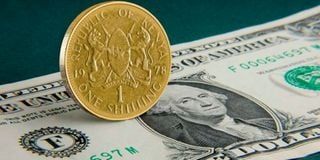How to ensure shilling holds up against dollar

The Kenyan shilling and the US dollar.
The Kenya shilling-versus-US dollar topic is a favourite in East Africa. On January 25, the dollar was exchanging at Sh163.50. On April 13, it was Sh127. And earlier this month, the greenback was trading at Sh132. But as many rejoice the strengthening of the shilling, others query the measures being taken to avoid its weakening.
It must be the February 12 Eurobond issuance and successful uptake that led to the strengthening of the shilling over a short period; it was not a result of increased trade and exports. Ideally, a currency would strengthen owing to factors such as greater influx of investments and increased productivity and trade. But we neither saw the GDP rise nor witness the fundamentals of the country change; the only new factor was the Eurobond.
Compare the dollar and the Kenya shilling and the strengthening of the latter against the Uganda shilling. Ugandans are converting their currency to Kenyan shillings and using it to procure dollars.
The Eurobond will be repaid in tranches. The threat of default does not exist. The market has been generous and participated in the uptake of the new bond and will continue participating in future uptakes should such issuance arise.
Fiscal policies
The government has, through fiscal policies, increased interest and tax rates. The 2024/25 Budget Policy Statement shows a target to boost revenue collection to over 20 per cent of GDP and tax collections of Sh2.95 trillion in the next fiscal year, up from the 2023/24 Sh2.62 trillion revenue target.
For instance, the high tax band has increased from 30-35 per cent, the introduction of a 1.5 per cent levy to fund the affordable housing programme and so forth. The gradual tax increase amid inflation means the purchasing power of Kenyans has been significantly reduced while essentials like food and healthcare get costlier.
The Central Bank has played a key role in the strengthening of the shilling. The Central Bank Rate (CBR) has been increased to 13 per cent since February 6. If it is reduced, the shilling could weaken. Economists say an economy grows when the government spends. For the next fiscal year, we are looking forward to a Sh3.7 trillion Budget, of which possibly Sh1.2 trillion will go into debt repayment.
Sh2.3 trillion
Of the balance, like Sh2.3 trillion could be allocated to recurrent expenditure—salaries, maintenance of assets and so forth. There will not be much for new infrastructure development. Also keep in mind that the Budget is aspirational as the tax revenues are less than Sh3 trillion. Lower spending power will eventually impact tax collections and employment. At the same time, the higher taxes are restricting mwananchi’s spending.
We must encourage and enhance local manufacturing and push for greater foreign direct investment (FDI). As the Nairobi Securities Exchange (NSE) marks 70 years, a solid strategy to attract foreign investors for the listed companies would be ideal. All these aspects play a role in answering the question: Is the shilling going to remain strong and how can we ensure a strengthened currency?
Mr Ritesh is a business and financial analyst. [email protected].





